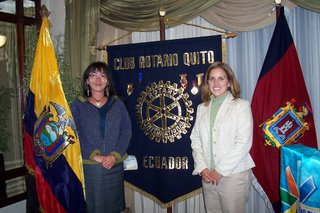
I am so sorry that it’s taken me almost a month to update the blog, but it’s been a whirlwind month in the life of Lauren. Being in Quito during the holiday season was an eye-opener, as it was a really different experience. Pictured at left is the Rotary Christmas party, and it was quite a grand event. Quito was very alive with the Christmas spirit. Many people put their Christmas trees outside on their terraces, and practically every family had a nativity. The churches also constructed massive nativity scenes, and there was even a scene in the local market made out of only fruits and vegetables! The streets turned into seas of green and red, and a shopping frenzy really did hit the city. It was interesting seeing the families that had the financial means to buy gifts and those who didn’t. Many poor families came from the smaller towns to beg for money, and the highways and city streets were literally packed with begging children asking for charity during the holidays. Some kids even held ropes across the roads to force cars to stop (and hence make the driver pay the children to drop the rope). I’ve never seen so many begging children in my life. Many Quiteños that I’ve talked to have said that they really dislike Christmas because it’s hard to see so many needy, starving families. Others protest the consumerism that hits the city, and I even saw a Santa Claus (stuffed) being hanged from a bridge in the city with a sign that said “consumerism will suffocate you”. My impression is that there are very mixed feelings about Christmas. A lot of people hand out little packages of candy and animal crackers, but I was so tired of seeing people give the children candy that Kjell and I went to buy toothbrushes and toothpaste to hand out to the children. We went with an Ecuadorian friend of mine to an orphanage to hand them out (pictured below), and we later just walked the streets and gave them to the children. (A lot of the beggar families come prepared though, and we even saw them toting sacks full of hand-outs they had received). I didn’t see anything at all relating to Hanukkah, which was sad, but thanks to the people who sent me such beautiful cards.
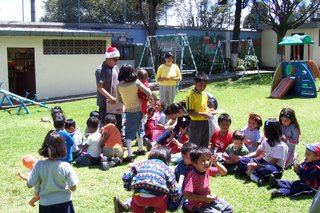
Quiteños celebrate Christmas more on the 24th than on the 25th. This seems to be the case with most holidays here, as I think they prefer to sleep and recover on the actual day. I helped Juana (house mom) a little to prepare Christmas dinner, and I made my grandmother’s famous potato salad and lemon pudding. Juana liked the Thanksgiving dinner I made so much that she insisted on fresh pumpkin pie again! The whole family came to the house, which was really nice because I hadn’t met any of the family prior to Christmas. The tradition is to eat at 12 a.m. on the 25th, but we gave in at 10 p.m. We also exchanged gifts after dinner. It was really nice to spend this time with them, and I loved seeing how another family celebrates the holiday. They don’t really lavish each other in gifts. It’s more about cooking and being together all day.
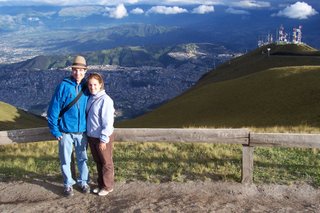
As many of you know, Kjell came on December 16th, and we traveled around Ecuador and Peru. We had such a great time, and it was such a treat to have my own body guard for two weeks. We saw all of the highlights of Quito (the virgin statue, parks, museums, the Teleferiqo, markets, malls, etc.), and we even squeezed in a salsa lesson at my favorite place. We traveled to Mindo, a very tranquil jungle-ish town that has tons of birds, butterflies, and orchids. It was literally one street long, so it was really quaint. We saw absolutely amazing waterfalls, and we went on really long hikes (one of which was straight up the side of a mountain with only a rope to help us along). It really was a nature lover’s paradise, so it was a much appreciated change from Quito.
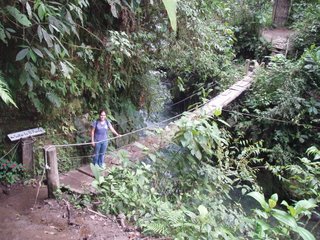
After having gone to the very touristy Otavalo market in the north, I wanted to go to a more authentic, indigenous market, so we went to a town called Saqusilí, and it was a sight to be had. We were two of six tourists (yes, we counted), because the town was pulsing with indigenous people buying their weekly goods, and we stuck out like a sore thumb. There were four markets in close proximity: a potato maket, a textile market, a fruit/veggie/miscellaneous market, and an animal market (which completely blew me away). The animal market had a very distinct smell of fish mixed with chicken, guinea pig, and rabbit, so you can only imagine how long we lasted there. We saw tons of people crowded around big cloth sacks, and we didn’t understand what was going on. Plus, where were all the animals? It turns out that the rabbits and guinea pigs (cuy) were in the sacks because the sacks were moving! We saw tons of live chickens and cuy, and I still can’t get used to the idea of eating guinea pig (but we did- keep reading).
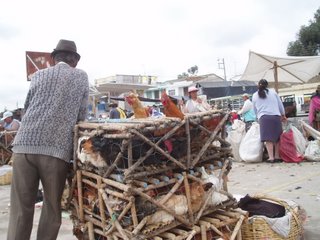
After the Saqusilí experience, we ventured to the Cotopaxi volcano, which is close to a town called Latacunga. It was a stressful adventure just getting there, but it was worth the anxiety because we hiked to the refuge, in the snow no less, and it was an impressive sight! One day we are hiking in tropical forests and the next we are half-way up an active volcano. We definitely hadn’t planned for snow, and we were in our tennis shoes and jeans. We, the two bumbling Floridians, quickly realized that we were in for it and succumbed to wetness and extreme cold. When we entered the refuge we saw everyone else in their Gore-tex and super-human strength hiking equipment, and we felt really ridiculous. The next day we ventured off to a volcanic crater lake called Laguna Quilatoa. We went with the brother (and family) of my favorite professor, so it was an interesting experience to spend the day traveling with an Ecuadorian family (advantages and disadvantages). After getting horribly lost, we finally got to the most beautiful lake I have ever seen. (Other than Bear lake). Its piercing blue/green color coupled with majestic rock/mountain formations circling it created for a truly unique sight. We hiked down to the bottom and took “donkeys” back up the almost vertical climb. The donkeys were a riot because we rode them bareback, and they were really lame, so were laughing the whole way.
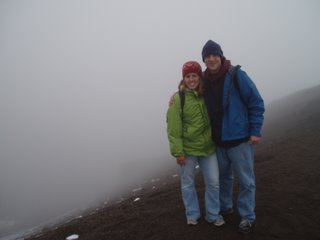 (Yes, that's snow and ice behind us. Can you see the snowflakes on my eyelashes?!!!)
(Yes, that's snow and ice behind us. Can you see the snowflakes on my eyelashes?!!!)
Kjell and I also had the chance to go to Otavalo so he could see the craziness that goes on there as well. Otavalo doesn’t even hold a candle to Saquisilí, however. We later went to Cotocachi, a small town to the north of Otavalo, because its specialty is leather goods. Kjell is now the best-equipped French teacher in the state of Florida! Later we went to a lake near the town called Cuicocha. I had to haggle with the taxi driver (why do they all try to take advantage of tourists without fail?), but we got there. It was another stellar view. We hiked up the ridge a little bit, and as we ascended we had a 360 degree panoramic view of the beauty of Ecuador. Amazing!
 On Christmas day, Kjell and I ventured to Peru. This was an adventure and a half. We flew to Lima, and I had heard that Lima was really dangerous, so I was on high alert. We had the taxi driver take us to the center to town for a short tour, and Lima is really a beautiful city. I had been so scared of it that I was really surprised to see how much it offered. The town square was amazing, and the supreme court building, along with the colonial style buildings, are truly worth visiting (more than a night, that is). We then moved on to Cusco, the hub and starting point of the Machu Picchu adventure. Cusco is a really quaint city, and we walked the whole thing in one day. We were completely museumed out by the end of the day. We tried coca tea for the first time, and it tasted like normal tea. It’s entirely legal, as cocaine production relies on other chemical agents and literally tons of coca leaves. We tried some mystery soups and food in Cusco as well, and we paid dearly for this. While in Cusco we saw really interesting remnants of Inca architecture and stonework. The Spanish colonizers built on top of the Incan ruins, which created for really interesting structures of stone on the bottom and Spanish architecture on the top and for the walls. The streets are cobblestone and are really narrow. Some streets still have the old, Incan walls, and we even saw the famed 12-sided stone and the “puma” shape that’s said to exist in the rock wall. (The puma was one of the most important and sacred animals for the Incas.)
On Christmas day, Kjell and I ventured to Peru. This was an adventure and a half. We flew to Lima, and I had heard that Lima was really dangerous, so I was on high alert. We had the taxi driver take us to the center to town for a short tour, and Lima is really a beautiful city. I had been so scared of it that I was really surprised to see how much it offered. The town square was amazing, and the supreme court building, along with the colonial style buildings, are truly worth visiting (more than a night, that is). We then moved on to Cusco, the hub and starting point of the Machu Picchu adventure. Cusco is a really quaint city, and we walked the whole thing in one day. We were completely museumed out by the end of the day. We tried coca tea for the first time, and it tasted like normal tea. It’s entirely legal, as cocaine production relies on other chemical agents and literally tons of coca leaves. We tried some mystery soups and food in Cusco as well, and we paid dearly for this. While in Cusco we saw really interesting remnants of Inca architecture and stonework. The Spanish colonizers built on top of the Incan ruins, which created for really interesting structures of stone on the bottom and Spanish architecture on the top and for the walls. The streets are cobblestone and are really narrow. Some streets still have the old, Incan walls, and we even saw the famed 12-sided stone and the “puma” shape that’s said to exist in the rock wall. (The puma was one of the most important and sacred animals for the Incas.)
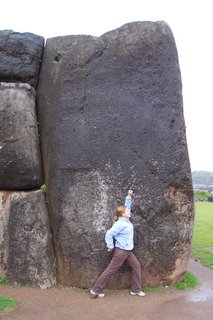 The next day we went to a valley that certainly lives up to its name: the Sacred Valley. It is a valley of gorgeous scenery and Inca ruins. We first went to Sachsaywaman and saw the amazing, ragged (yet purposeful) creation of the Incas. Some of the rocks were 5 times my height (which yes, I know isn’t that much of a feat given my stature, but you get the point). We then went to Pisaq, which was my favorite. We saw old Incan “baths”, and I learned more about the ingenuity and precision of the Incas. They constructed conduits for running water, and they figured out exactly what kind of architecture was necessary to withstand earthquakes. Amazing. From there we traveled to Ollantaytambo or “Ollanta” for short, and this was another remarkable Incan fortress. By the way, I learned that there were only 13 real Incas in history. Only the kings of the tribes were called Incas. The people they ruled over were called Quechuas, and they never received the title of Inca, for it was only reserved for the kings. Also, the women never wore gold in these times, as gold was the symbol for man, and silver was the metal for women. Our tour guide’s wedding ring, for example, still carried this tradition, as it was a mix of silver and gold. It also wasn’t believed that gold was very precious (more precious was the spondylus shell). The Incas believed that gold was the earthly representation of the sun, their deity. It was thought to be masculine while the moon was feminine. Thus, the earth was in perfect harmony between sun and moon (woman and man).
The next day we went to a valley that certainly lives up to its name: the Sacred Valley. It is a valley of gorgeous scenery and Inca ruins. We first went to Sachsaywaman and saw the amazing, ragged (yet purposeful) creation of the Incas. Some of the rocks were 5 times my height (which yes, I know isn’t that much of a feat given my stature, but you get the point). We then went to Pisaq, which was my favorite. We saw old Incan “baths”, and I learned more about the ingenuity and precision of the Incas. They constructed conduits for running water, and they figured out exactly what kind of architecture was necessary to withstand earthquakes. Amazing. From there we traveled to Ollantaytambo or “Ollanta” for short, and this was another remarkable Incan fortress. By the way, I learned that there were only 13 real Incas in history. Only the kings of the tribes were called Incas. The people they ruled over were called Quechuas, and they never received the title of Inca, for it was only reserved for the kings. Also, the women never wore gold in these times, as gold was the symbol for man, and silver was the metal for women. Our tour guide’s wedding ring, for example, still carried this tradition, as it was a mix of silver and gold. It also wasn’t believed that gold was very precious (more precious was the spondylus shell). The Incas believed that gold was the earthly representation of the sun, their deity. It was thought to be masculine while the moon was feminine. Thus, the earth was in perfect harmony between sun and moon (woman and man).
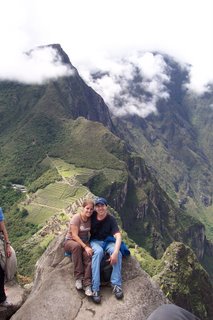
The next day (day 3) we began our Machu Picchu adventure. It was absolutely unforgettable (for good and bad reasons)! The travel agency I had booked with overlooked us, so we had some glitches, but needless to say, we arrived at kilometer 104 of the train, and we began our two-day Inca trail adventure. We hiked for about seven hours the first day. The trail itself was more exposed than I would have liked, as power lines were visible, but after a while we climbed further into the mountain, and the beautiful landscape slowly revealed itself to us. We trekked through about four different climates, as some parts were quite dry, others were tropical, others were downright rainy and muddy, and others were so thick with fog that we could barely see ten feet in front of us. I learned that in olden days there was not just one Inca trail, but rather about eight trails existed, and they spanned from the northern tip of Colombia through Ecuador, Peru, Bolivia and more to the south as well. They were paths for the Inca tribes and warriors to travel from tribe to tribe. They moved goods and really vital information through these paths. Runners in the day used to carry ropes that had been tied in knots in a special way (but a trained person) to another tribe, and there used to be only one person who understood the knots and who could relate the message to the town. This way if the runners were captured with the message, the captors would not be able to decipher the message written in knots. The runners used to run on the Inca trail with a satchel of coca leaves to give them energy without having to eat because the leaves contain iron, calcium, and other vital nutrients.
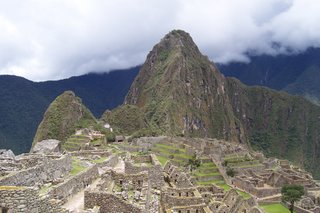
The rain at the end of the day was really quite strong, so I was really worried that we wouldn’t be able to see Machu Picchu. However, as we approached the “postcard” lookout point, the clouds opened, and there was one of the most awesome sights and feats of human creation staring me in the face. After walking all day thinking about what it was going to look like, Machu Picchu revealed itself to us, and I was completely overwhelmed by its grandeur. Kjell and I literally stopped in our tracks to soak it all in. The mountains that surround it are enormous, and they make you feel like you are simultaneously trapped and free in the valley. We stayed in the nearby town of Aguas Calientes, and the next day, we rose with the roosters and were at Machu Picchu at 6:30. It was a perfect time to go, as the dense clouds slowly began to lift, and we were able to witness the transformation of Machu Picchu practically by ourselves because the throngs of tourists hadn’t arrived yet. Our tour guide explained the many parts of Machu Picchu to us, and then we had a few hours to roam. We saw the living quarters of the nobility and commoners, the common areas, the amazing condor creation and many other things. The sun-dial was quite impressive as well. Apparently, the creators of the national Peruvian beer, Pilsen, wanted to film a commercial in Machu Picchu and somehow “sneaked” a crane into the ruins. The arm of the crane fell and chipped off the most vital part of the sun-dial, and we could see the damage. Can you believe that the company ruined one of the best sun dials of all time just to make a measly beer commercial?
Kjell really wanted to climb up Waynapicchu, the mountain that frames the ruins in the background of all the pictures. They only allow 400 people to climb every day, so we were really lucky to go up, STRAIGHT up, that is. We ascended in record time, and we were able to see Machu Picchu from a really neat angle, as we were perched really high above the ruins. I can’t say enough about Machu Picchu. It completely blew me away. On the way back to Cusco, we took a really hilarious tourist train, and the attendants gave us a song and dance show. As if that wasn’t enough, they then put on a ridiculous fashion show trying to entice the customers to buy alpaca goods. By the way, alpaca is absolutely amazing. I know understand why the Bolivian president, Evo Morales, wears it everywhere.
After our amazing Machu Picchu triumph, we decided that it was time to finally try the Andean delicacy that we’ve been fearing for so long: cuy (guinea pig). We decided to have it oven baked instead of fried because we really couldn’t stomach the idea of biting into crunchy guinea pig skin. It was presented to us in traditional fashion- head, teeth, paws and all. Yummmm. It was then quartered for us, and we dug in. Firstly, there really isn’t much meat on a guinea pig, and secondly, it had a really distinct taste, and I didn’t like it one bit. I should probably try it again, but it may be a while, because I associate it with severe food poisoning. Who knows what exactly it was that we ate, but Kjell and I became violently ill on the way home to Quito. Nothing really is as embarrassing as fainting in the isle of a packed plane. Yep, that’s precisely what I did. I thought I was dreaming but then I realized that all of the Spanish-speaking people that were crowded over me were real (as was the orange juice that was running down my face). Fainting+trying to speak in Spanish after fainting really just through me for a loop. Poor Kjell was worse off than I was, and he got to such a point that I decided to take us to the hospital. Going to a hospital at 3 a.m. in a developing nation is kind of a scary thing, but everything turned out fine. It turns out that we both had severe bacterial infections and parasites! I like to think it’s E. Coli because that sounds more interesting, right? I was really disappointed that we were so sick because I had been looking forward to New Year’s eve so much. The Ecuadorians have so many fascinating superstitions. They burn huge, stuffed dolls, change into yellow underwear, eat 12 grapes, and run around the block with packed suitcases at midnight. They also cross dress a whole lot, and it’s more like the U.S. Halloween. Oh well, next year! Anyway we’re back to normal now. I’m studying again at my academy, and life in Quito has resumed.
A happy, healthy, and prosperous 2007 to everyone!

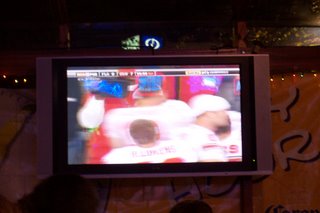 I know this picture is blurry, but can you see the time and quarter? 1st quarter, 14:45 on the clock, and what's the score? 7-0!! I honestly thought it was all over...
I know this picture is blurry, but can you see the time and quarter? 1st quarter, 14:45 on the clock, and what's the score? 7-0!! I honestly thought it was all over...




 (Yes, that's snow and ice behind us. Can you see the snowflakes on my eyelashes?!!!)
(Yes, that's snow and ice behind us. Can you see the snowflakes on my eyelashes?!!!)




